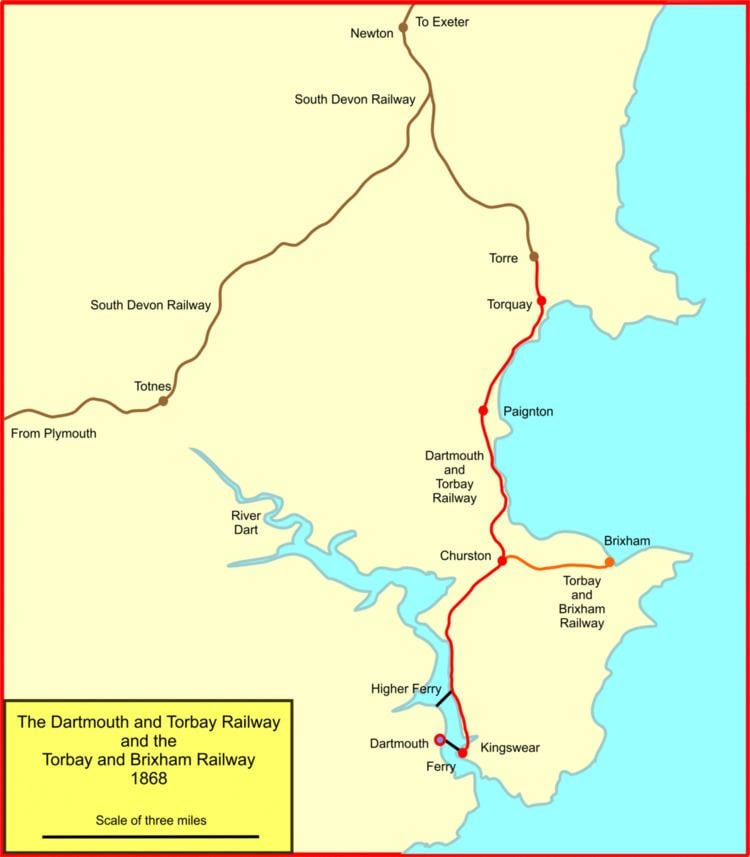 | ||
The Dartmouth and Torbay Railway was a broad gauge railway linking the South Devon Railway branch at Torquay with Kingswear in Devon, England. It was operated from the outset by the South Devon Railway.
Contents
The line to Paignton is now part of First Great Western's Riviera Line, the remaining section is operated by the Heritage Dartmouth Steam Railway.
History to 1865
Torbay and Dartmouth had considerable commercial importance in the early nineteenth century. The South Devon Railway (SDR) opened its line to from Exeter to Newton Abbot—the station was called simply Newton at first—on 31 December 1846, and to a Torquay station—later renamed Torre—on 18 December 1848. The "Torquay" station was inconveniently located due to difficulty in Parliament over land acquisition required for a more central site. Moreover, the SDR had other issued to contend with following the collapse of the atmospheric system on which it had focussed its technical attention, and the difficulty of reaching its primary goal, Plymouth.
The need to extend the line was obvious and it fell to a local concern to propose the construction. The Dartmouth and Torbay Railway Company was incorporated by Act of Parliament of 27 July 1857 to build from the SDR Torquay station to or near Dartmouth, and power to establish a ferry from Kingswear to Dartmouth, and to take over the existing Dartmouth Floating Bridge Company.
The course of the southern portion of the route proved controversial and the first opening was from the SDR "Torquay" station to Paignton on 2 August 1859. The new Company provided its own Torquay station and the SDR station was renamed Torre. This short section was exceptionally difficult in engineering terms due to the difficult terrain; it included 20 bridges, a viaduct and a tunnel of 133 yards (122 m), at Oil Cove.
The next section was from Paignton to Brixham Road (later renamed Churston); it opened to passengers on 14 March 1861 and to goods on 1 April 1861. This too included difficult engineering: Goodrington Marsh had to be crossed, and there were two masonry viaducts. The Brixham Road station was about two miles from Brixham, and important fishing port.
Dartmouth was still an objective but would have involved an awkward crossing of the River Dart and this was abandoned: by Act of 7 July 1862 an extension of time for completion was granted, and the route was altered to run to Hoodown, later extended to Kingswear on the east bank of the Dart. The line was opened from Brixham Road to Kingswear for passenger traffic on 16 August 1864; goods were not conveyed until 2 April 1866. A steam ferry from Kingswear to Dartmouth was operated from the day of passenger opening. This section too was difficult, involving considerable earthworks, a 495 yard (453 m) tunnel, a masonry viaduct near Greenway and two timber viaducts on piles, across Longwood and Noss Creeks.
The lengths of the line, all single track, were:
Later history
The line was worked and operated from the outset by the South Devon Railway, and it was leased to them in perpetuity from 1 January 1866. After that time the Company was a financial entity only until 1872, when it was formally absorbed into the SDR.
Brixham Road station was a poor facility for the important fishing town of Brixham, and an independent company, the Torbay and Brixham Railway constructed a short line to directly serve Brixham. It opened on 28 February 1868 to passengers, goods traffic being handled from 1 May 1868. The line was 2 miles and 6 chains (3.3 km) long, and joined the Dartmouth and Torbay Railway at Brixham Road station, which was renamed Churston from the day of opening of that line.
On 1 February 1876 the South Devon Railway amalgamated with the Great Western Railway and the Bristol and Exeter Railway, forming the new Great Western Railway. As the Dartmouth line was then part of the SDR, it became a part of the GWR.
The West of England lines of the GWR, including the lines of the former Dartmouth and Torbay Railway, were converted from the original broad gauge of 7 ft 0¼in to what was now standard gauge, 4 ft 8½in in a huge engineering project over a single weekend, from 20 May 1892 and 23 May 1892.
The tunnel at Oil Cove, south of Torquay, was opened out in 1910. It was replaced by the bridge that carries Torbay Road.
The two wooden viaducts, Longwood and Noss, a short distance north of Kingswear, were abolished and the line deviated to by-pass them in 1921.
On 1 November 1972 the line between Goodrington Sands and Kingswear was transferred to private ownership and operated as a heritage railway.
Stations
For stations opened on the line after take over by the Great Western Railway please see Riviera Line and Dartmouth Steam Railway.
Dartmouth Ferry
The Dartmouth ferry is now operated by the heritage Dartmouth Steam Railway.
